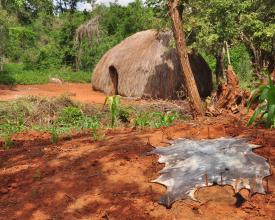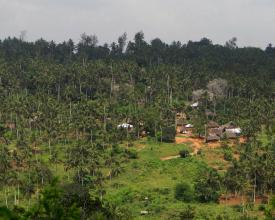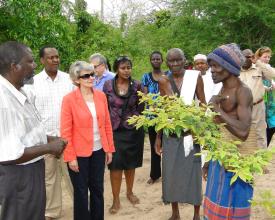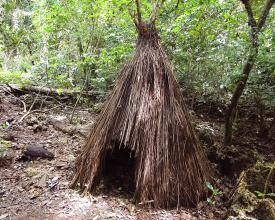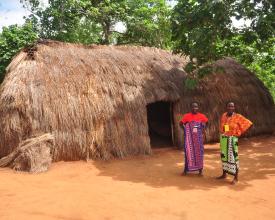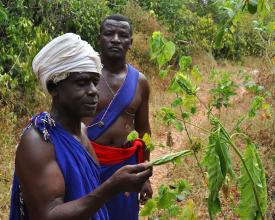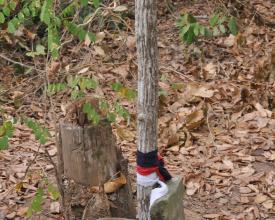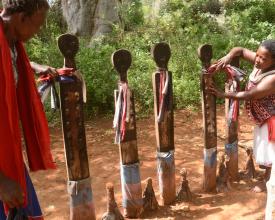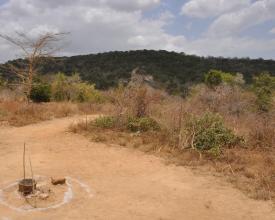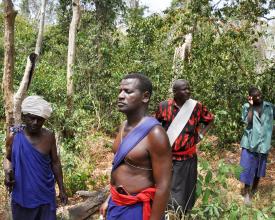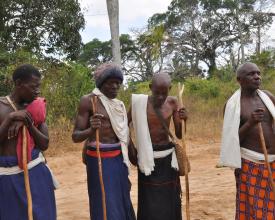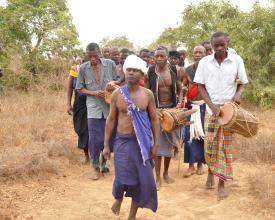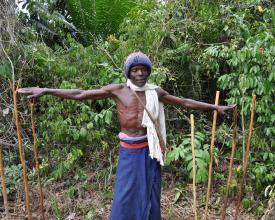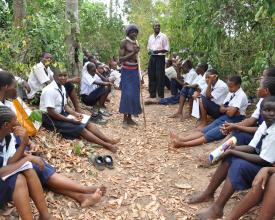
Integrated protection of the cultural and natural heritage of the Sacred Mijikenda Kaya Forests
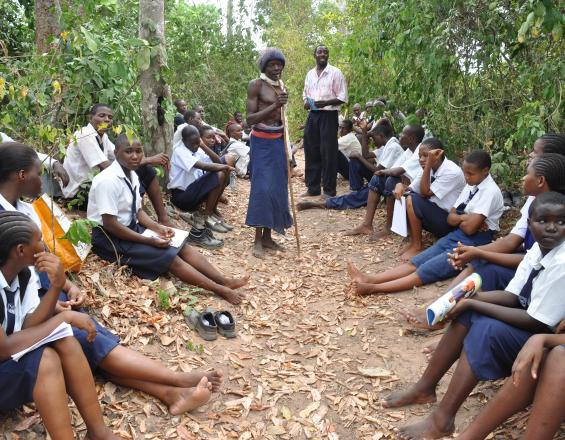
The Kayas and the sacred forests of the Mijikenda community are a unique place for the conservation of botanical species endemic of the East African coastal forests and they considered as the carriers of group identity due to their status as sacred places and home to the Mijikenda.
The solution focuses on preserving the natural environment surrounding the Kayas through the continuation of a management approach based on the traditional knowledge of the Mijikenda and the principles of self-restrain supervised by spiritual leaders and the Council of Elders (Kambi). The protection of these outstanding sites is further supported by the National Museums of Kenya which protects the sites at the institutional and legal levels.
This unique connection of nature, culture and sacredness has led to the inscription of the Sacred Mijikenda Kaya Forests in the World Heritage List and the Mijikenda traditions and practices on the list of Intangible Cultural Heritage in Need of Urgent Safeguarding.
Context
Challenges addressed
- Environmental challenges:loss of forest areas; unsustainable exploitation and use of natural resources; commercial harvesting; agricultural pressure. Population increase and the resultant pressure on land resources
- Cultural and social challenges: loss of traditional knowledge; changes in socio-cultural settings have weakened traditional structures; fragmentation of local and indigenous communities; abandonment of the Kayas; changes in demographic and in lifestyles and religious intolerance towards the sacredness and the spiritual beliefs of the Mijikenda; urbanization and urban development pressures. Lack of proper documentation and lack of recognition by relevant stakeholders, lack of administrative and national legal frameworks to enhance the protection of physical and non-physical elements.
- Economic challenges: need to create means of sustainable development and differentiation of local sources of income; decreased economic sustainability of local communities.
Location
Process
Summary of the process
The protection of the sacred Kaya forests requires a complex system of value recognition, partnerships and multi-level protection of the site. The overarching framework is interlinked and interdependent character of natural, cultural and spiritual values as well as the important role played by the custodianship of the Mijikenda and the kaya elders in the protection of these values and the bio-cultural diversity of the place. This demonstrates of the fundamental role played by indigenous and spiritual values in the protection of nature.
The traditional regulatory system of the Mijikenda has been in place for over four centuries and it has allowed for the conservation and protection of the Kayas until modern day. With modern challenges of abandonment of the Kayas, loss of traditional knowledge and commercial interests, the protection of the Kayas has required the establishment of more institutional and governmental means of support for the protection of the Kayas and the elders involved in the conservation and protection of the site. The inscription under the provisions of World Heritage and the ICH Conventions have further strengthened the support in place for the protection of both tangible-intangible characters of the place and its communities.
Building Blocks
Sacred and cultural values of the Mijikenda Kaya Forest
The Mijikenda Kaya Forest are small patches of forest land that extend between 10 and 400 ha on the coastal plains of Kenya. They were originally created in the 16th century as places of settlement but after their abandonment in the 1940s these places have been defined mostly for their spiritual and religious values. The Kaya forests play a key role in the Mijikenda religious sphere, their beliefs and practices as they are regarded as the ancestral and sacred homes of the Mijikenda peoples.
The protection of the Mijikenda Kaya Forests require an holistic and integrated approach based on both natural and cultural values as well as the recognition of the role of the Mijikenda in the conservation of the site through traditional knowledge systems and the recognition of the sacredness of these places. This multilayered identification and protection of values is fundamental for the protection of the site and its people in their wholeness: from the safeguarding of their sacredness to the conservation of their bio-cultural diversity.
Enabling factors
The traditional knowledge of the Mijikenda is key for the Kayas sacred land and the conservation of their nature and culture. The sacredness of the place is expressed by the Mijikenda through the practicing of traditions and performing arts related to important life events of the Mijikenda, these traditions form the code of ethics and are the basis of the governance system in place. The effective conservation is further supported by the National Museums of Kenya which has over the years worked with the Mijikenda for the protection of the Kayas.
Lesson learned
The long-term protection of the Kayas is directly dependent on the survival of the Mijikenda and their traditions. The protection of the natural environment of the Kaya forests is based on the recognition of the sacred values given to nature. These values are protected and safeguarded by the Mijikenda through their traditional knowledge but also the application of the code of ethics and governance system as well as the enforcement of self-restraining principles by communities. For this reason, it is important to address socio-cultural challenges at the site and to work with the Mijikenda on the establishment of intergenerational exchanges to support the continuation of these practices and the safeguarding of cultural and sacred values.
The application of the codes of ethics and rules of the Mijikenda has long allowed for the conservation, however, the changing demographic of the Kayas and the abandonment of these areas in favor of urban environments has led to the need for further strengthening the institutional and legal frameworks (both traditional and governmental) of the Kayas.
The custodianship of the Mijikenda
The protection of the Kaya forests of coastal Kenya is a primary matter of the Mijikenda, nine Bantu-speaking ethnic groups (Chonyi, Duruma, Digo, Giriama, Jibana, Kambe, Kauma, Rabai and Ribe). The Mijikenda peoples recognize their origins in the Kaya forests and they have established traditional regulatory systems and codes of ethics based on the sacredness of the Kaya forests and the practice of spiritual and sacred traditional performances like prayers, oath taking, burials, charms, naming of newly born, initiations, reconciliations, coronations and others. The use of natural resources within the Kaya forests is regulated through the traditional knowledge and practices of the Mijikeda. These practices forbid any active and commercial exploitation of natural resources, and they allow only for the collection of dead logs and plants used for spiritual and medicinal purposes. These traditional practices contribute to the conservation of the biodiversity of these forests.
The observation of these codes of ethics is supervised by the Council of Elders (Kambi) and the spiritual leaders of the Mijikenda people, which are in charge of ensuring that traditional regulatory systems are not breached and the forest is respected
Enabling factors
The survival of the Kaya forests is highly dependent on the livelihood of the Mijikenda and their traditional system. As community members move towards urban areas, the survival of these practices and traditions is in the hands of the elders of the Mijikenda peoples. Project and programs has been established to foster intergenerational exchange for the long-term safeguarding of these spiritual and traditional practices, which are beneficial for the bio-cultural diversity of the place and the sustainability of traditional owners.
Lesson learned
The custodianship exercised by the Mijikenda people is of great importance to the survival of both the natural and cultural/spiritual values of the Sacred Kaya forests. However, the communities of the Mijikenda are slowly degrading: with the increased population of the area and the need for local sustainability, Mijikenda members have abandoned the place to live in urban areas. These issues have been tackled through two key means: strengthening the national-level institutional and protective framework (designation as a national monument and creation of the Coastal Forest Conservation Unit within the National Museums of Kenya) and the inscription of the traditions and practices of the Mijikenda on the list of Intangible Cultural Heritage in Need of Urgent Safeguarding.
Traditional knowledge and supporting regulatory systems: institutional and regulatory partnerships for the protection of the kaya forests
The protection of the Sacred Mijikenda Kaya forests is ensured through a double set of traditional and legal measures that interact with each other to protect the place and ensure the livelihood of communities and peoples. On top of the existing traditional regulatory framework of the Mijikenda and the Council of Elders (Kambi), all the 10 Kaya forests inscribed on the World Heritage List and many of these sacred forests have also been registered as national monuments under the provisions of the National Museums and Heritage Act, which mandates the Kenyan government to support the kaya elders in the protection of the Kayas. The original registration of 22 kaya forests in 1992 has sparked the need to establish a new dedicated unit – the Coastal Forest Conservation Unit - within the National Museums of Kenya whose work is still today focused on working in partnership with the kaya elders for the protection of these places.
Enabling factors
This building block is enabled by the existence of partnerships between the Mijikenda and the relevant governmental institutions in charge of protecting the natural and cultural heritage of the places at the local (traditional regulatory systems), national (national acts and legislation) and international (World Heritage and the Intangible Cultural Heritage Conventions). This cooperation offers the chance for all rights holders and stakeholders to work together and it is a platform for communication between traditional owners and government institutions.
Lesson learned
The depletion and degradation of the socio-cultural fabric of the Mijikenda people has led to the need to establish an institutional framework for supporting and working in cooperation with the kaya elders for the conservation of these sacred forests. The traditional regulatory system in place is one set of protection that is observed mostly by community members but the degraded understanding of the role of the Kayas in the life of the Mijikenda and other local communities has progressively led to the need for more institutionalized support through the establishment and implementation of legal protection frameworks with defined penalties for infringements of laws and regulations.
Additionally, the commercial harvesting interests in these areas, the pressing urban and agricultural encroachment and pressures to use the land of the Kayas have called for the need of effective legal protection by the government in order to comply with the requirements of the World Heritage Convention.
Synergetic protection under UNESCO’s Conventions: World Heritage and Intangible Cultural Heritage
The protection of the Kayas is directly dependent to the protection of both the natural and the cultural – both tangible and intangible – attributes/elements of the site and its traditional knowledge system and practices. This need for integrated protection is not only reflected at the local level though the recognition of custodianship, sacredness and the important bio-cultural role of the Kayas but it is also recognized and protected internationally through the inscription of the site on the list of the Convention Concerning the Protection of the World Cultural and Natural Heritage (inscribed as the Sacred Mijikenda Kaya Forests) and the inclusion of the Traditions and practices associated with the Kayas in the sacred forests of the Mijikenda in the list of elements in Need of Urgent Safeguarding of the UNESCO Convention for the Safeguarding of the Intangible Cultural Heritage.
The double inscription offers an added international framework to tackle both the protection of the natural and cultural heritage as well as the Outstanding Universal Value of the Sacred Mijikenda Kaya Forests. Additionally, it supports efforts made in directly addressing the need to urgently and proactively engage with the safeguarding of traditions that are facing significant challenges and might one day disappear.
Enabling factors
The inscription on the World Heritage List and on the Intangible Cultural Heritage Convention has been a collective effort by the State of Kenya, the National Museums of Kenya, the Kenyan National Commission for UNESCO and the Mijikenda peoples.
These adequate conservation, protection and safeguarding of the Kayas is possible through the active network of traditional and institutional partners engaged in the conservation of the site at the local, regional, national and international level.
Lesson learned
The World Heritage Convention deals with the protection of the Outstanding Universal Value of a site and the attributes carrying such values, on the other hand the Intangible Cultural Heritage Convention focuses on cultural heritage of traditions, living expressions inherited by ancestors and previous generations. These inscriptions officialized the recognition of the interdependent character of the tangible and intangible values of the site, for which protection is necessary both in terms of natural and cultural heritage as well as the safeguarding of the traditional knowledge of the Mijikenda in their role as traditional owners and custodians.
The inscription in the ICH in Need of Urgent Safeguarding has supported the establishment and creation of activities for the safeguarding of the traditions and practices of the Mijikenda (restoration work, intergenerational exchanges, awards for best managed Kaya Forests), as well as community safeguarding activities such as beekeeping and sale of honey, butterfly farming and sale of pupae to international markets for socio-economic sustainability of the neighboring Kaya local communities.
Impacts
Environmental and natural conservation is strengthened by the recognition of the forests as sacred places that cannot be exploited for economic purposes; strengthening ecosystem-services.
The conservation of the nature and culture are interdependent: on one side the recognition of nature as sacred is key to the conservation of the forests and the environment of the Kayas and on the other hand the conservation of nature is necessary to retain the cultural and spiritual values associated to the Kayas and the sacred forests of the Mijikenda. These places are maintained as sacred places and burial grounds by the local communities led by their elders. Access to the Kaya forests is controlled and entry is only allowed to the initiated elders (and in some cases not even them). Non-initiated members and visitors can only access these places with permission from the elders. Special rituals and resource utilization can be granted via special authorizations.
The spiritual connection between the memories of ancestors who lived and were buried in these places and the natural reinforces the sacredness, and justifies the need for their protection and negative exploitation.
The sustainability of local livelihoods and communities. The local inhabitants depend on these forests for food security, water sources and “storehouse” for traditional medicine and herbs for community health care.
Beneficiaries
The beneficiaries of these integrated protections are the Kayas and the Mijikenda. Further beneficiaries are local communities and govenmental insitutions (particularly in relation to the authority of Elders).

